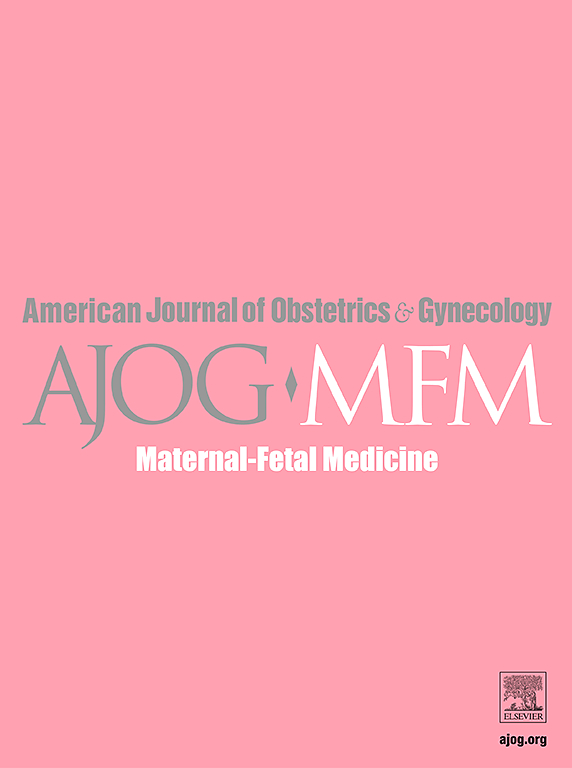双胎妊娠早期联合子痫前期筛查——纳入IPSISS(瑞士实施子痫前期筛查)队列的前100例双胎妊娠的结果
IF 3.1
2区 医学
Q1 OBSTETRICS & GYNECOLOGY
American Journal of Obstetrics & Gynecology Mfm
Pub Date : 2025-08-17
DOI:10.1016/j.ajogmf.2025.101760
引用次数: 0
摘要
背景:先兆子痫(PE)在双胎妊娠中比单胎妊娠更常见。双胎妊娠早期联合筛查包括母体危险因素、子宫动脉搏动指数(UtA-PI)、平均动脉压(MAP)和胎盘生长因子(PlGF)。然而,据报道,与单例相比,性能较差。目的:本试验的目的是评估瑞士IPSISS队列中前100例双胎妊娠的pe筛查效果。研究设计:这是一项在瑞士进行的前瞻性多中心注册研究,包括在2020年6月至2024年6月期间注册的所有双胞胎和单胎妊娠,具有完整的筛查参数和结果数据。3263例单胎妊娠和104例双胎妊娠纳入本分析。有早产PE风险的孕妇根据当地指南给予低剂量阿司匹林(LDA)。所有参数通过FMF网站(胎儿医学基金会)上的在线计算器转换为中位数倍数(MoM)。计算器。研究工具。https://fetalmedicine.org/research/peRisk)。比较单胎、单绒毛膜(MC)和双绒毛膜(DC)双胞胎的参数。使用GraphPad Prism 10.0 for Windows进行统计分析。使用学生t检验或Mann-Whitney u检验分析连续变量,使用Fisher精确检验或Chi2检验和Kruskal Wallis检验评估比例。结果:活产单胎妊娠早产子痫前期(pPE)的发生率为29/3'221(0.9%),双胞胎为5/101(5.0%)。在平稳妊娠中,中位MAP [IQR]在MC双胞胎中显著高于单胎,但在DC双胞胎中没有(88.5mmHg[85.4-98.0]对86.3mmHg [81.0-91.5], (p=0.005))。DC双胞胎的中位UtA-PI [IQR]明显低于单胎和MC双胞胎(分别为1.40 [1.05-1.65]vs 1.50 [1.20-1.9] (p=0.0006)和1.60 [1.35-1.80](p=0.022))。中位PlGF [IQR]在DC双胞胎中显著高于单胎,但在MC双胞胎中没有(55.0pg/ml [43.5-79.1] vs . 41.0pg/ml[31.0-53.8])。结论:本研究表明,在我们的队列中,与单胎妊娠相比,这些标记物在双胞胎妊娠中的表现符合预期,并且在固定SPR下,与单胎相比,更晚发生PE的双胞胎妊娠较少。我们的初步结果表明,在筛查双胎妊娠pPE时,必须选择比1:100更高的临界值,相应的SPR更高,才能达到可接受的检出率。摘要:IPSISS队列中前100例双胞胎妊娠的子痫前期筛查分析表明,必须使用高于1:100的临界值来筛查双胞胎的早产子痫前期。本文章由计算机程序翻译,如有差异,请以英文原文为准。
First-trimester combined screening for preeclampsia in twin pregnancies—results of the first 100 twin pregnancies included in the IPSISS (Implementing Preeclampsia Screening in Switzerland) cohort
BACKGROUND
Preeclampsia is more common in twin pregnancies than in singleton pregnancies. First-trimester combined screening, including maternal risk factors, uterine artery pulsatility index, mean arterial pressure, and placental growth factor, is possible in twin pregnancies. However, the performance is reported to be inferior compared with that in singletons.
OBJECTIVE
This study aimed to assess the performance of preeclampsia screening in the first 100 twin pregnancies included in the Implementing Preeclampsia Screening in Switzerland Study cohort in Switzerland.
STUDY DESIGN
This is a prospective multicenter registry study performed in Switzerland, including all twin and singleton pregnancies included in the registry with complete screening parameters and outcome data, between June 2020 and June 2024. A total of 3263 singleton and 104 twin pregnancies were included in this analysis. Pregnancies considered at risk for preterm preeclampsia were prescribed low-dose aspirin according to local guidelines. All parameters were converted to multiples of medians by the online calculator on the Fetal Medicine Foundation website (The Fetal Medicine Foundation, Calculators, Research Tools [https://fetalmedicine.org/research/peRisk]). Parameters were compared between singleton, monochorionic, and dichorionic twins. Statistical analysis was performed using GraphPad Prism 10.0 for Windows. Continuous variables were analyzed using the Student t test or Mann–Whitney U-test, whereas proportions were evaluated using the Fisher exact test or chi-squared test and the Kruskal–Wallis test.
RESULTS
The incidence of preterm preeclampsia in singleton pregnancies with live births was 29 of 3221 (0.9%) as opposed to 5 of 101 (5.0%) in twins. In uneventful pregnancies, median mean arterial pressure (interquartile range) was significantly higher in monochorionic twins compared with singletons, but not in dichorionic twins (88.5 [85.4–98.0] vs 86.3 [81.0–91.5] mm Hg; P=.005). Median uterine artery pulsatility index (interquartile range) was significantly lower in dichorionic twins compared with singletons and monochorionic twins (1.40 [1.05–1.65] vs 1.50 [1.20–1.9] [P=.0006] and 1.60 [1.35–1.80] [P=.022], respectively). Median PlGF (interquartile range) was significantly higher in dichorionic twins than in singletons, but not in monochorionic twins (55.0 [43.5–79.1] vs 41.0 [31.0–53.8] pg/mL; P<.0001), and median PAPP-A (interquartile range) was significantly higher in both dichorionic and monochorionic twins compared with singletons (9.72 [5.12–14.06] and 6.89 [4.13–11.59] vs 3.25 [1.81–5.15] IU/L [P<.0001], respectively). In twin pregnancies that later developed preterm preeclampsia, PlGF multiples of the median (interquartile range) were significantly lower than in uneventful twin pregnancies (0.52 [0.44–0.81] vs 0.99 [0.67–1.41]; P=.012), whereas all other markers showed no significant difference. At a fixed screen positive rate, significantly more twin pregnancies with preterm preeclampsia were screen-negative than singleton pregnancies with preterm preeclampsia.
CONCLUSION
This study demonstrated that, in our cohort, the markers performed as expected in twin compared with singleton pregnancies, and that at a fixed screen positive rate, fewer twin pregnancies with subsequent preeclampsia were detected compared with singleton pregnancies. Our preliminary results showed that a higher cutoff than 1:100, with a corresponding higher screen positive rate, must be chosen when screening for preterm preeclampsia in twin pregnancies to achieve an acceptable detection rate.
求助全文
通过发布文献求助,成功后即可免费获取论文全文。
去求助
来源期刊

American Journal of Obstetrics & Gynecology Mfm
Medicine-Medicine (all)
CiteScore
7.40
自引率
3.20%
发文量
254
审稿时长
40 days
期刊介绍:
The American Journal of Obstetrics and Gynecology (AJOG) is a highly esteemed publication with two companion titles. One of these is the American Journal of Obstetrics and Gynecology Maternal-Fetal Medicine (AJOG MFM), which is dedicated to the latest research in the field of maternal-fetal medicine, specifically concerning high-risk pregnancies. The journal encompasses a wide range of topics, including:
Maternal Complications: It addresses significant studies that have the potential to change clinical practice regarding complications faced by pregnant women.
Fetal Complications: The journal covers prenatal diagnosis, ultrasound, and genetic issues related to the fetus, providing insights into the management and care of fetal health.
Prenatal Care: It discusses the best practices in prenatal care to ensure the health and well-being of both the mother and the unborn child.
Intrapartum Care: It provides guidance on the care provided during the childbirth process, which is critical for the safety of both mother and baby.
Postpartum Issues: The journal also tackles issues that arise after childbirth, focusing on the postpartum period and its implications for maternal health. AJOG MFM serves as a reliable forum for peer-reviewed research, with a preference for randomized trials and meta-analyses. The goal is to equip researchers and clinicians with the most current information and evidence-based strategies to effectively manage high-risk pregnancies and to provide the best possible care for mothers and their unborn children.
 求助内容:
求助内容: 应助结果提醒方式:
应助结果提醒方式:


